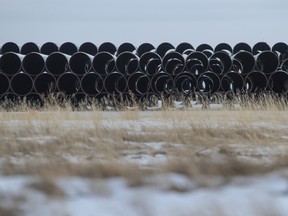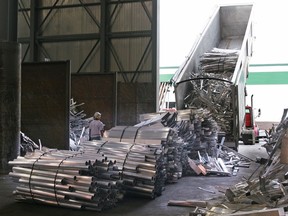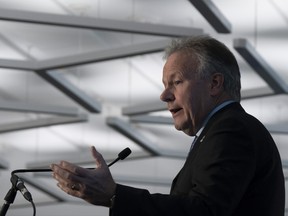Energy Minister Jonathan Wilkinson has cautiously welcomed reviving talks over an Energy East-type project
Article content
Persistent talk of reviving plans to build an oil pipeline to Eastern Canada — particularly from quarters previously perceived as opposed to such projects has caught many in the oilpatch by surprise, though it may be gaining favour in the face of Donald Trump‘s repeated exhortations that Canada become an American state.
Article content
Article content
“The rules of the game have changed over the last few days,” Industry Minister François-Philippe Champagne said during a CTV Question Period interview Sunday when asked whether he would support a pipeline through Quebec. “And that may mean that we need to be able to have transmission lines that could bring electricity east-west; that may mean that you need pipelines that would go west-east,” he said.
Advertisement 2
Article content
Champagne said Canada cannot be dependent on one country for its exports.
“I think people understand better now the nexus between energy security, economic security and I would even say, national security,” he said.
But plenty of ill feeling still lingers in the oilpatch from the collapse of the Energy East pipeline project first proposed in 2013 by TransCanada Corp. (now TC Energy Corp.), which would’ve converted and extended a stretch of the company’s existing Canadian Mainline for natural gas to carry crude from Western Canada to Saint John, N.B.
The project faced some stiff opposition, particularly in Quebec, before TransCanada pulled the plug in 2017, citing regulatory delays and obstacles.
TC’s focus is now on natural gas infrastructure and power generation since completing the spinoff of its oil pipelines business into South Bow Corp. in October.
“Ottawa would have been much better positioned to handle trade negotiations in general — and less dependent on the U.S. specifically — if LNG or other export pipelines and infrastructure had been operational years ago,” TC Energy chief executive François Poirier said in a Wall Street Journal op-ed last week.
Advertisement 3
Article content
The idea of reviving talks over an Energy East-type project was cautiously welcomed last week by Energy Minister Jonathan Wilkinson, who called it a “vulnerability” that Canada has become so reliant on the U.S.
“We’re all aware now that perhaps there are some vulnerabilities we did not actually believe existed,” he said. “We should be reflecting on the vulnerabilities and deciding collectively, including with our First Nation partners, whether there are some things we should do to address these vulnerabilities.”
Around 80 per cent of Canada’s five million barrels per day in crude production flows to the U.S., according to energy intelligence service Argus Media Ltd.
Canada’s reliance on a single trading partner makes its energy industry highly sensitive to tariffs that could devalue the price of its barrels and curb the productivity of the Canadian oilpatch and the royalties and taxes it generates, said Peter Tertzakian, an economist and founder of the Arc Energy Research Institute, who attended Prime Minister Justin Trudeau’s closed-door gathering of business leaders in Toronto on Friday.
Article content
Advertisement 4
Article content
After weeks of largely dismissing repeated jabs from Trump, Trudeau said the threat of annexation was a “real thing” and the reason behind it is that the U.S. administration wants Canada’s critical minerals and other resources and wants the U.S. to benefit from them.
“But Mr. Trump has it in mind that one of the easiest ways of doing that is absorbing our country. And it is a real thing,” he said, according to the Toronto Star.
Trump seemed to confirm Trudeau’s remarks, at least in part, during a pre-Super Bowl interview on Fox, where he was asked if his desire to see Canada become the 51st state was real: “Yeah, it is. I think Canada would be much better off being a 51st state,” he said.
In a separate scrum with reporters Sunday on Air Force One, Trump announced plans for a 25 per cent tariff on all steel and aluminum imports to the U.S., including from Canada.
“They do almost all their business with us and if we say we want our cars to be made in Detroit, with the stroke of a pen I can do that, and other things in addition to that, would not allow Canada to be a viable country,” he said.
Tertzakian, who sits on the prime minister’s council on Canada-U.S. relations, said Trudeau is serious about not trivializing Trump’s words.
Advertisement 5
Article content
“(Trump) says it once, he says it twice, OK. But if he says it 10 times, you have to take it seriously,” he said, adding that Canada has desirable resources, including a wealth of critical minerals, oil and gas, uranium, agriculture and water. “The reality of the geopolitics is that Canada is a very valuable territory.”
The threat of a trade war with the U.S. and the volatility it has unleashed is driving calls for Canada to diversify its trading partners and reopening old debates over pipelines and federal regulatory hurdles on resource development.
At Trudeau’s hastily assembled economic summit on Friday, participants discussed knocking down internal barriers to trade, with a chorus of voices also urging rapid regulatory reform to speed investments in ports, power transmission, pipelines, LNG facilities and mining.
Trump is threatening a 10 per cent tariff on Canadian energy, while all other imports from Canada could be hit with a 25 per cent levy; Canada was given a 30-day reprieve on Feb. 3 following discussions between Trump and Trudeau over border security measures.
Advertisement 6
Article content
The discount on Canada’s heavy crude oil, Western Canadian Select (WCS), had climbed to US$16.25 per barrel on Jan. 31 compared to U.S. benchmark West Texas Intermediate (WTI) in anticipation of Trump’s tariffs before dropping back down after the 30-day pause was announced, narrowing to US$13.45 at the close of last week.
Wilkinson, the energy minister, however, suggested Canada’s lack of a west-to-east oil pipeline isn’t just an economic problem. He pointed out that much of Ontario and Quebec’s oil comes via Enbridge Inc.’s Line 5, which transports Canadian crude through Wisconsin and Michigan before re-entering Canada near Sarnia, Ont.
The cross-border pipeline has already been a political target in Michigan, where the state governor sought to shut down a portion of the line.
“The realization is setting in, particularly in central Canada, that they get the majority of their oil and gas from the United States. They don’t get it from Canada,” Tertzakian said. “We are very vulnerable to actual energy security issues, which is another and far more serious issue than just the dollars and cents of tariffs.”
Advertisement 7
Article content
On Canada’s West Coast, there have been calls to speed up the second phase of the Shell PLC-led LNG Canada project, ahead of the facility’s start-up later this year, and British Columbia Premier David Eby pledged to accelerate permits for a list of approved projects in critical minerals, natural gas, power generation and transmission.
But boosting volumes on the expanded Trans Mountain pipeline (TMX) is broadly understood in the oilpatch as the most practical short- to medium-term manoeuvre available in the face of U.S. tariffs.
Currently, TMX is around 80 per cent full, but a rapid rise in spot shipping on the 890,000-barrel-per-day pipeline is expected to occur if tariffs proceed.
A project is underway to improve nighttime navigation at Trans Mountain Corp.’s Westridge Marine Terminal in the Port of Vancouver to boost export capacity to around 34 Aframax tanker loadings per month, the company said Friday.
RBC Capital Markets reported that 20 tankers departed from the Westridge terminal in December.
There is also an opportunity to enable larger export cargoes by dredging beneath the Second Narrows Bridge in B.C., Trans Mountain said, since vessels cannot fully load currently due to draft restrictions.
Advertisement 8
Article content
This could reduce the current demand for vessel transits through the Second Narrows and benefit other port trade in the area,” the company said in a statement.
Recommended from Editorial
-

Nuttall: It’s time to unleash Canada’s resource potential
-

Enbridge cancels plans for gas pipeline in B.C.
Overall, Tertzakian said there’s a big shift in recognizing that we need to upgrade all our infrastructure.
“If we’re going to shift our export focus, we have to upgrade our ports, LNG facilities and, yeah, pipelines, particularly to tidewater, to places like the West Coast, (including the) expansion of Trans Mountain (and) potentially reviving Energy East,” he said. “This is vital to our economy. We are the fourth-largest producer of oil and gas in the world. We export way more than we produce, but we are not energy secure.”
mpotkins@postmedia.com
Bookmark our website and support our journalism: Don’t miss the business news you need to know — add financialpost.com to your bookmarks and sign up for our newsletters here.
Article content
Pipeline sentiment shifts as Trump says for Canada is ‘real’
2025-02-10 18:57:53






